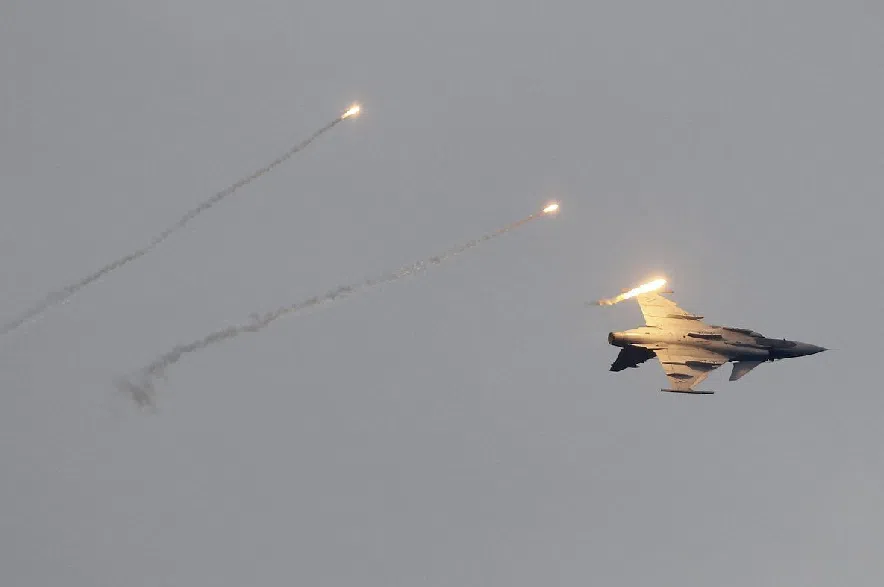Swedish aerospace giant Saab is considering Canada as a place to assemble Gripen fighter jets as it moves to quickly ramp up production to meet demand from Ukraine.
Saab’s CEO Micael Johansson said in recent interviews with financial news publications that Kyiv’s interest in purchasing more than 100 Gripen fighter jets would double the defence company’s production requirements.
Read more:
- McGuinty says Canada’s first defence industrial strategy will land weeks after budget
- U.S. approves sale of mobile artillery rocket systems to Canada
- Carney condemns Russia’s attacks on Ukraine’s energy during call with Zelenskyy
The Financial Times and the Reuters news agency reported Johansson said the company is searching for ways to expand production capacity, possibly in Canada or elsewhere in Europe.
On the sidelines of the Canadian Aerospace Summit in Ottawa, Industry Minister Mélanie Joly told The Canadian Press that this is “good news” and that she spoke with Johansson earlier in the day.
“I’ve been actively working with Saab to see what can be done to do more partnerships with Canada, and it starts with the Global Eye (surveillance plane), but also we’re willing to see what we can do to help support Ukraine,” she said.
The Global Eye, a long-range early warning surveillance aircraft, is jointly manufactured by Saab and Bombardier.
“We’re always willing to be able to have more foreign direct investments in Canada,” Joly said. “We see eye to eye when it comes to our position on Europe’s security and Ukraine, and we see eye to eye on the importance of our aerospace sector, and so I think there’s a great partnership between Canada and Sweden that we can further.”
Simon Carroll, president of Saab Canada, told the Canadian Aerospace Summit on Tuesday the company wants to expand its operations in Canada. He said while Global Eye aircraft are assembled in Mississauga, the last part of production is performed in Sweden, where the aircraft are outfitted with radars and sensors.
“We want to do more of this work in Canada because it makes good business sense,” he said. “Saab views Canada as the ideal partner with the right workforce to support massive growth in global demand. That means exporting from Canada, which helps create and sustain a longer-term aviation industry.”
Saab said the Gripen jets could be built and maintained in Canada when it tried to sell Ottawa on buying its fighters as a replacement for the CF-18s. It lost that contract to U.S. manufacturer Lockheed Martin and its F-35 stealth fighters.
Sweden and Ukraine signed a letter of intent last week in preparation for an export deal that would send up to 150 Gripens to the war-torn nation. No contract has been signed yet.
Ukrainian media outlets have reported President Volodymyr Zelenskyy is looking to build up a mixed fleet of some 250 fighter aircraft, including F-16s, Gripens and French Rafales.
The Gripens are seen as a priority since they’re easy to maintain and can take off from and land on roads, while their crews don’t take long to train.
On a recent third-quarter earnings call, Johansson said Saab is looking to add more production to its Gripen lines in Sweden and Brazil.
“We are initiating, as we speak, other partnership discussions in countries that would have an interest for the Gripen, of course,” he said on Oct. 24. “It will mean that we would need another hub beyond the hub we have in Brazil, and expanding in Linköping (Sweden) as well.”
Canada is meanwhile still mulling whether to proceed with its planned purchase of a fleet of 88 F-35 fighter jets.
Prime Minister Mark Carney called for a review of the major military procurement deal in response to U.S. President Donald Trump’s global trade war.
At a recent parliamentary committee hearing, Secretary of State for Defence Procurement Stephen Fuhr said the F-35 review report by the Department of National Defence has been sent to the Prime Minister’s Office.
“I’m sure the prime minister has opened the report,” Fuhr told the House of Commons national defence committee on Oct. 23.
“You may have noticed a number of things have been happening. The government has done a number of things, including this review, and the review is not complete. The most important thing here, regardless of how long it takes, is we make the right decision. It’s a massive investment.”
Joly told Radio-Canada in French earlier in the month the federal government has not ruled out a mixed fighter fleet. She said one option for Ottawa is to move forward with a small fleet of F-35s and also acquire a separate fleet of Gripens.
Joly visited Saab in Sweden in August and said after the trip that Ottawa’s review of the fighter jet purchase is fundamentally about protecting Canadian sovereignty, but also considers industrial benefits and jobs.
U.S. Ambassador Pete Hoekstra has bristled over the idea that Canada could procure a mixed fighter fleet and has warned it would be incredibly expensive for a country like Canada to maintain two fleets.
This report by The Canadian Press was first published Oct. 28, 2025.











